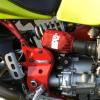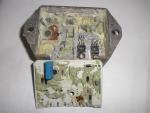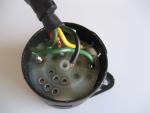-
Posts
2,345 -
Joined
-
Last visited
-
Days Won
61
Content Type
Profiles
Forums
Events
Gallery
Community Map
Everything posted by Kiwi_Roy
-
Roy as thankfully taken up the slack of losing Callison to the CARC cult Thank You! Actually I couldn't do much at all without those excelent Carl Allison drawings. All Guzzi owners owe him big time.
-
Make sure your regulator is well grounded, don't rely on the holding bolts, run a heavy ground wire between the regulator case and an engine bolt. Regulator Diode Tests.pdf Sometimes the regulators overload and melt the diodes. Do this simple test and get back to us, just unplug the yellow and red wires from the harness. Roy
-
+1 on the regulator grounding, I feel that's the main cause of regulator failure. Your bad idle and missing could be the ignition switch also, that happened to my V11 Sport, I found the switch would measure as high as 20 Ohms. You can check it from under the seat, pull R3 and measure the resistance from the top terminal (30) to common point at Fuse6/7, it should be Test Point Layout.pdf Several others have found a broken wire where it solders to the switch, check that also it might be touching then loosing contact intermittently, anchor the wires so they don't flex at the solder jont. Good Luck Roy
-
The EPROM chip in your ECU holds the program (Map) for the fuel and ignition, it can be re-programmed with a different map just like your computer can be upgraded with the latest Windows software.
-
Yes, that's a very good point but easily worked around, in my work I see semiconductors in parallel on large current loads and series on high voltages. Its OK to put an external one in parallel with the internal because it's disconnected anyway and if you put two in parallel that are each capable of carrying the full current thermal runaway is not an issue.
-
As I said so long as it's not shorted out it's OK. The ones I have disected the diode part is still OK but the lead has melted off so it's disconnected in effect. Actually since each diode has it's cathode connected to a red wire you could just cut the red wire and run it to your new diode that would be same as internal, neater in fact, I will update my drawing that way.
-
Yes, heres a picture of one where both diodes gave out, kindly sent to me by Savomir Musilek all the way from Czech republic. Top left is the diodes one has a lead laying beside it. The other lead you can see on the RH side of circuit board, they have been arcing away for quite a while, the owner probably was getting quite frustrated with low battery charging. Bottom right are the SCRs This ones quite fixable for a few cents, the diode leads can be re-soldered and a few other parts need replacing. It takes lots of patience to get the circuit board out and no gaurantee, sometimes the epoxy is just too hard. I was really only interested in the case.
-
Yes, but only if they are open circuit. Its too risky trying to open the case and fix them, I have done 2 successfully but a third the epoxy was so hard I destroyed the circuit board The diodes are connected directly between Yellow & Red so adding to the outside is simple and can be a permanent fix. I sent you a PM Roy
-
The regulator is something I know quite a bit about. The one on my V11 Sport was only charging weakly also so I pulled it apart and analyzed the circuit diagram. I made the mistake of unplugged the headlight relay thinking with less drain on the battery the weak alternator would be able to maintain enough charge, of course now I know this was exactly the wrong thing to do. Alternator Tests If you unplug the regulator and measure between the two yellow wires from the alternator you will get 60-80 Volts (I can't remember exactly) with the bike running. With the bike off you will get a good circuit ( Regulator Maintenance In my opinion a bad ground is what causes the regulators to fail, it fools the regulator into thinking the battery voltage is low so it turns hard on and overloads. Your regulator must have a perfect connection to ground. If it has a flimsy wire under one of the bolt heads I recommend supplementing this with a short jumper to one of the timing cover bolts. I actually drilled a hole in one of the fins and attached a jumper directly to that. At the very least remove it to clean and grease where it touches the chassis Wiring Tests - I assume you have the Ducati Energia Slip the black / white plug out a little so it's still connected but you can get your multimeter probe on the black wire pin. With the key on you should measure the battery voltage from there to the chassis, that Voltage is what turns the regulator on to charge the battery and tells it when to cut back. The voltage on this pin comes from the headlight relay via a red/black wire that also supplies several of the dash lights. On most bikes the headlight relay depends on the N/O contact of the start relay, you have a 5 pin relay there don't you? The red wires connect to the battery via a 35 Amp fuse so you should have a good low resistance from the connector to battery positive. The fuse is something to check also it shouldn't be getting warm, make sure the contacts are tight. Hopefully by this point you have found the problem, if not the next step is to check the regulator diodes, if 3 cases are enough to go by that's what gives out, refer to attached. Regulator Basic - With Notes.pdf If you find one of the diodes open, don't start hacking into the regulator, it's quite tricky getting on apart in one piece, I have a work around fix. Relay Base Contacts If you have a loose connection in the base of Start or headlight relay it's possible the regulator is not seeing the correct reference Voltage on it's Black wire but this would result in overcharging not what you are experiencing. Overcharging may cause regulator failure however. Relay Base Repair.pdf Hopefully this will get you going, if not look for a PM. Cheers Roy
-
Yes, post on the MyECU site. They sorted mine out pretty quick.
-
Yes, the second relay from the front is the headlight relay. Do you by any chance have a 4 pin relay in position 1, that won't work Pull out relay 2 and measure for voltage at the top (30) contact, it should be there with key off or on. Here's something that might help Test Point Layout.pdf Once you have established there's 12 Volts at the top of R2 you can check if it's picking. With the key On and engine not running the charge light should be on if not another way to confirm R2 is picking up by measuring the red/black wire at the regulator, that has 12V when the key is on and R2 is closed. If it doesn't your bike will not charge the battery. Further along the 12V goes through a multi pin connector and to the front brake switch, you should see 12V there (key On) If it's all OK up to there next thing is to check for voltage at the dimmer switch. Check for Voltage at the lamp, it's also possible you have lost your ground connection to the chassis. I assume you have checked the connectors. I also assume the engine starts as normal and the tail lamp and brake lights go. If you don't have a meter a 12 Volt lamp will do, connect one terminal to the chassis. Regards Roy
-
That's a good idea if you want to add heated clothing or some other serious loads. The GPS however will only draw about 200 mA so it would be OK on an existing circuit, the dash area has a couple. BTW, if you're thinking about cutting the plug off your GPS cable and wiring it in place just check that it is 12 Volts between the plug and GPS before you do i.e. bare the two wires and measure the voltage with it plugged in first, just in case it's something like 6.
-
You can pick up 12 Volts at the tacho from the red/black wire. That wire comes from the headlight relay so it's on when the ignition is on.
-
I just happened on this thread again. I have been studying the drawings for Guzzis after 2005 and it seems they have made a big step backwards in the wiring dept. The start relay used to be powered this way - Fuse, Start relay, solenoid Now it's going Fuse, Ignition Switch, fuse, start relay, solenoid, thats stupid. The starter solenoid wants to draw about 50 Amps so if you have even the slightest resistance in the ignition switch , say 0.5 Ohms you get less than half what it needs. The early bikes would still start easily with 10 - 15 Ohms resistance in the ignition switch because their relays were wired properly IMHO. Whoever came up with the solution to cut the yellow wire at Start Relay and power it from the battery via a new fuse should take a bow. (makes it like a V11 or LeMans) My oppologies to others who have pointed out the problem
-
Because the head is at an angle it's hard to judge when you have the drill / tap square on, next time I do one I will try to figure out some sort of mandrill e.g. something like a block of metal that has been drilled square on a bench drill. Failing that have something square attachced to one of the other screw holes as a guide.
-
If theres no where handy I would make a loop in both ends of a U shaped wire and put it under the two holding screws then ty-wrap the harness to it. I went to a bike shop and the guy gave me a handfull of stainless steel pushbike spokes, great for little jobs like that
-

New Member with a Newsed Guzzi and Blown Fuse.
Kiwi_Roy replied to twinsrule's topic in Technical Topics
Have you got this sketch Starter Circuit.pdf It sounds like a bad main contact but it could also be oxidation of the battery terminal. Air gets in between the lug and terminal, forms lead oxide which is an insulator. If this happens to the main Positive wire the fuse will pop very quickly. Pull the terminals off (negative first, back on last) and scrape the posts with a knife then apply some Vaseline. The Vaseline protects the metal from air so it can't Oxidize. Relay Base Repair.pdf It's real easy to tighten the relay base contacts, a sliver of scrap metal is all you need to get them out. Cheers Roy -
One of my riding buddies complained that his direction indicators on his 2000 era LeMans weren't working. From the symptoms I suspected a bad contact in the ignition switch, this is what he found. The wire is broken off the left hand end of the green jumper, this is what happens when wires flex at a soldered joint, they bend just where the solder ends and snap very quickly compared to a crimped joint. You can see the red wire is also getting ready to snap. All the flexing is taking place between the end of insulation and the solder. The cable needs to be anchored so that it flexes elsewhere and it should be a gentle twisting over several inches rather than a sharp bending in one spot. This is the second case I have seen of wires snapping at the switch. The switch contacts should measure very low resistance A high resistance in the switch can also cause the engine to cough and fart about.
-
It might be more cost effective to take it to a shop that has the right size heli coil, the tap would be quite expensive for just a one off. I bought a 6mm kit to do my rocker covers about $35. I have seen a cheaper kit for doing spark plugs, perhaps that's an option, most garages would have one of those I would think.
-
JB weld something in there with a cap on or perhaps just a suitable size nut. Wine bottle cork boiled in water to make soft. Seriously if you can get someone to put in a heli coil, thats a fix better than original. Roy
-
The fuel shouldn't come back out the pressure regulator so as long as you have the petcock on the left side closed all you should get is whats in the hose, pump and filter. Find a couple of small bungs to block the hose. There are two sets of wires on mine, one for the petcock the other for the low fuel sensor. Rou
-
Here in Canada we don't have a light switch, it's manditory to have the headlight on for bikes and cars. I think the US are starting to follow suit. I'm in favour of that. Roy
-
I might be out to lunch but I just went through the same symptoms with a Honda Goldwing the revs were several seconds behind the throttle. It turned out the slow running jets were blocked and the idle adjustment had been wound in so it was idling on the main jet. After cleaning out the idle jets and backing off the throttle stops there is no comparison. Now I know your bike is injected and mine is carbs but I thought it might trigger a thought like running way too rich. idle screws too far open or something similar. Roy
-

I grounded positive batt post to ECU. with an allen wrench
Kiwi_Roy replied to murphy3303's topic in Technical Topics
Don't feel bad, we've all done it, some more than once. Glad you got it sorted, post a picture of your bike Roy -

I grounded positive batt post to ECU. with an allen wrench
Kiwi_Roy replied to murphy3303's topic in Technical Topics
LOL That sounds funny BUT it could definitely be the easiest problem to fix! I wish I would have thought of it. First rule of electrical troubleshooting - check the stupid stuff first, I don't know how many times ignoring that has cost me hours.



